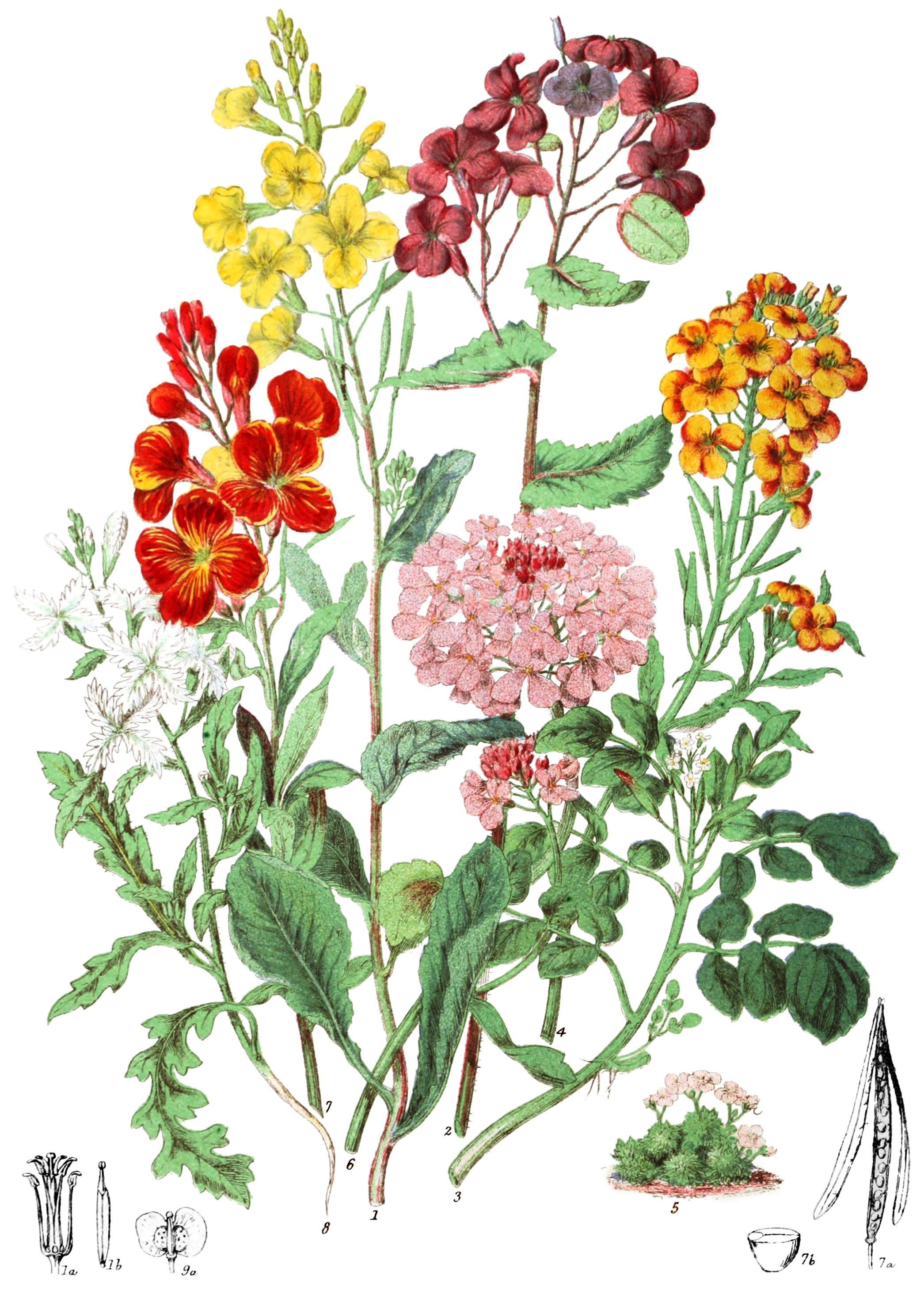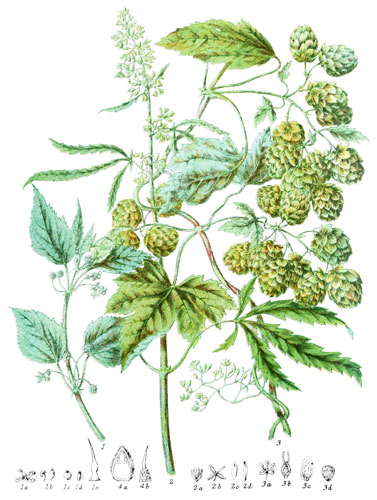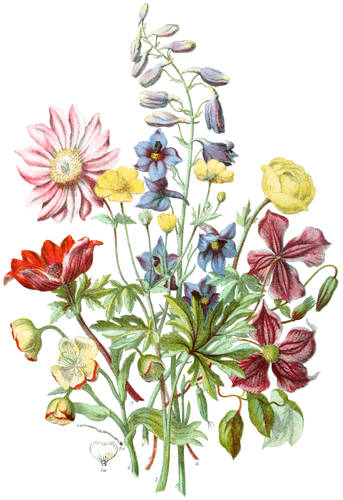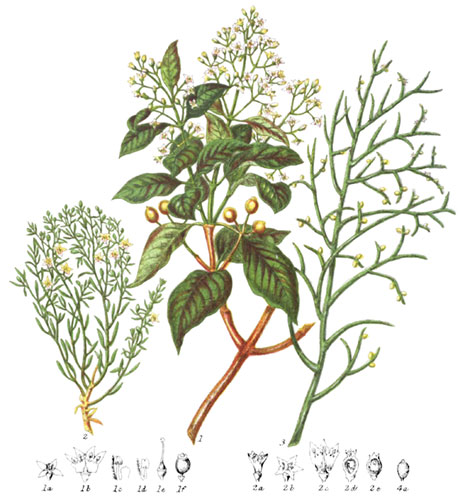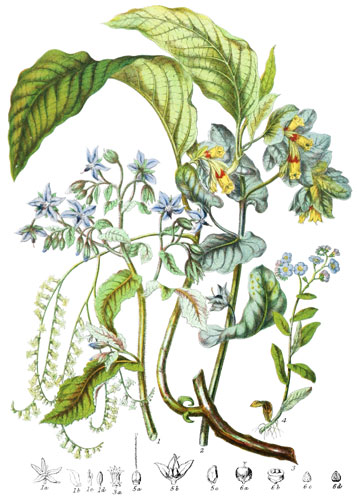Key characteristics
Herbaceous plants, and a few half shrubs. The leaves are alternate. The flowers are chiefly yellow or white, some are purple, without bracts, generally on branching stalks. The sepals of the calyx are four, falling off before the capsule is enlarged. The petals are four, cruciform, alternate with the sepals, occasionally toothed. The stamens are six, the four longest in pairs, the two short ones single and place between the pairs. On the disk are green honey-glands, between the petals and the stamens and ovary. The ovary is above the calyx and disk, with plates from the edges usually meeting in the centre. The stigmas are two, placed opposite the plate-bearing seeds. The seed-vessel is a silique, a long pod containing many seeds; or a silicule, a short pod with few seeds; opening by two valves separating from the central plate, or remaining close. The seeds are attached by a little cord in a single row to each side of the plate, generally pendulous; they have no albumen.
This Order has close affinity with Capparidaceæ, and in some points it agrees with Papaveraceæ, but the structure of the seed-vessel and seed is peculiar.
Nitrogen exists in these plants; some are very acrid, but none poisonous; many are stimulant and extremely wholesome; the seeds yield oil.
Select plants in this order
Not all plants listed are illustrated and not all plants illustrated are listed.
- This is one of the most clearly defined of the Natural Orders, but is a remarkable instance of the variety developed from one type. Brassica is the principal genus, being the stock from whence are derived the numerous varieties of Cabbage, Turnip, Cauliflower, Rape, and others; thus offering a large supply of nutritive food, and a considerable quantity of oil.
- B. oleracea (1) grows abundantly on the chalk cliffs of Dover, but in its natural condition would scarcely be recognized as the parent of the thousand-headed Cabbage, or the Brussels Sprouts. The different kinds all require a temperate as well as moist climate; Britain and Holland are the countries most favourable to their cultivation; in Germany also they succeed and in immense supply of Kohl is consumed in the fermented state of Sauerkraut. The tree-kail, or cow-cabbage of France, attains the height of 16 feet.
- B. rapa furnishes the various kinds of Turnip, of great importance as food for cattle.
- B. napus is Rape, the seeds of which contain an excellent oil.
- B. sinensis is cultivated on the hills and plains in Northern China, chiefly for the sake of the oil; of late years it has been introduced into France, and is found to afford valuable food; the golden flowers are highly fragrant, as are several of this tribe. In Kerguelen’s Isle a kind of cabbage is acceptable to sailors who land there.
- Nasturtium officinale (3) contains Iodine; of our native vegetables it is the cheapest and most wholesome, and is of such ready growth that a never-failing supply is maintained for the poorer classes; so great is the demand for this humble plant in the metropolis, that in some gardens in the vicinity, as at Watford in Hertfordshire, it is cultivated in small shallow canals in perennial plenty.
- N. pusillum is used in Brazil as medicine.
- Sinapis yeilds a salad in its first pair of leaves, and mustard from its pungent seeds.
- Lepidium, the early Salad-cress.
- Cochlearia, the stimulant Horse-radish.
- Crambe maritima, transplanted from our south shores into gardens about a century ago, becomes when grown and bleached the delicate Sea-kail.
- R. sativus, from china, furnishes the eatable Radishes;
- R. caudatus bearas a pod longer than the whole plant.
- Moricandia arvensis of the South of Europe is excessively acrid, yet a favourite food of camels.
- Farsetia parviflora is the Arabian Cress of the Desert.
- Lunaria (2) is so called from its moon-shaped silicules, which are of a silvery whiteness when ripe.
- Erysimum was a plant known to the ancients;
- E. Petrowskianum (4) is a late addition to our gardens.
- Petrocallis is one of the mountain species which adorn the rocks of the Alps and Pyrenees.
- The chief favourite of this tribe is the Wall-flower (7); when wild, on old walls and ruins, the flowers are pure yellow, but the garden variety is streaked with the richest crimson; the scent is extremely fragrant, and few spring flowers give so much gratification to all classes. Some species of the Cheiranthus belong to Madeira and Teneriffe.
- Iberis is an exception to the regular coralla, two of the petals being larger than the others.
- I. amara grows on chalk soil in England;
- I. umbellata is the garden Candy-tuft.
- I. gibraltarica (6) is one of the species inhabiting Spain.
- One of the prettiest of our spring flowers in meadows and copses is the Cardamine pratensis, Cuckoo-flower, mingling its pale purple blossoms with Cowslips and Wood-anemones.
- Isatis tinctoria, Woad, contains a blue dye, used by the Britons to colour themselves; before Indigo was plentiful, it was employed for dyeing cloth.
- Hesperis tristis is the night-scented Rocket of Italy, of a dull hue, like the Mathiola tristis, also fragrant by night.
- The various double Stocks produced from M. incana of our south cliffs are well-known.
- Anastatica Hierochuntia, the Rose of Jericho, has given rise to many superstitious tales; as the plant withers it becomes uprooted, and rolls up into a dry ball; when moistened it expands to its original shape, the pods open, and the seeds are scattered.
- Subularia aquatica is a singular example of flowers opening below the surface of water.
- Schizopetalon (8) differs from the usual type in having deeply notched petals, and four leaves to the seed instead of two.
- Brachycarpea varians is one of the few shrubby cruciferous plant. The hairs of the leaves or stalks are very interesting objects of examination under the microscope; those of Brassica oleracea are simple; of Draba, forked; of Alyssum, stellate at the summit.
Legend
- Brassica oleracea, Common Cabbage. Chalk Cliffs, England.
- Stamens and pistil.
- Pistil.
- Lunaria biennis, Honesty. England.
- Nasturtium officinale, Water-cress. Streams, England.
- Erysimum Petrowskianum. Palestine.
- Petrocallis pyrenaica. Pyrenees.
- Iberis gibraltarica, Spanish Candytuft. Gibraltar.
- Cheiranthus Cheiri, Wall-flower. England.
- Silique, opened.
- Section of Seed.
- Schizopetalon Walkeri. Chile.
- Silicule of Thlapsi latifolium.*
*9 was labled as 9a in the original illustration but 9 in the description.
Explore more
Posters
Decorate your walls with colorful detailed posters based on Elizabeth Twining’s beautiful two-volume set from 1868.
Puzzles
Challenge yourself or someone else to assemble a puzzle of all 160 botanical illustrations.
